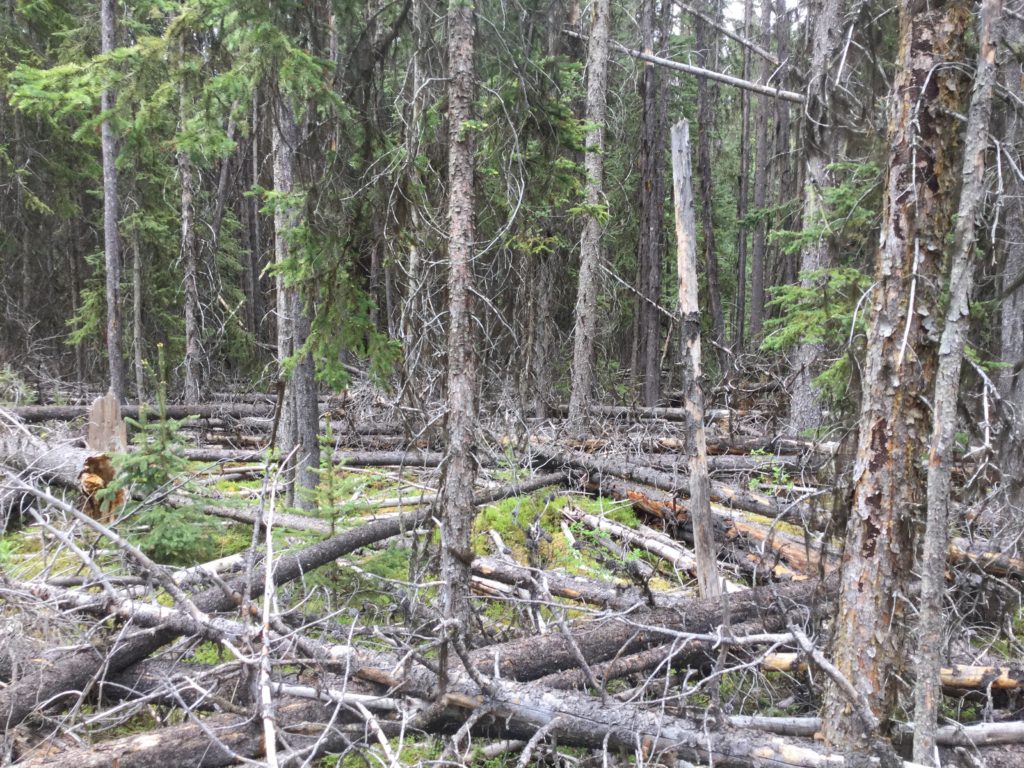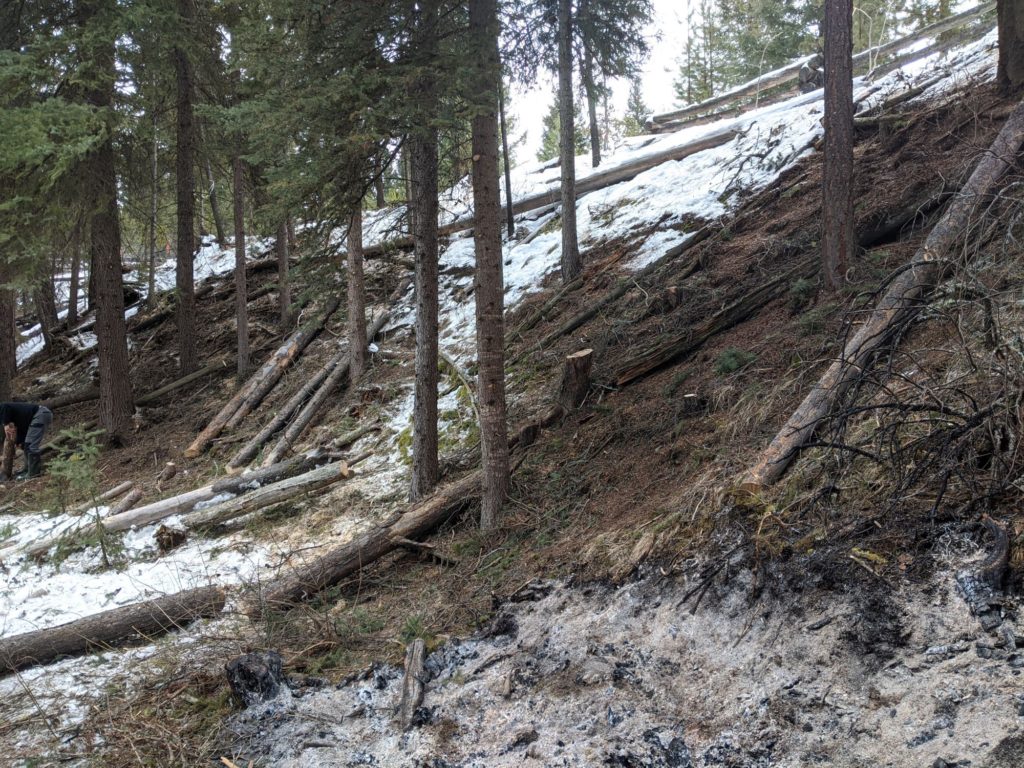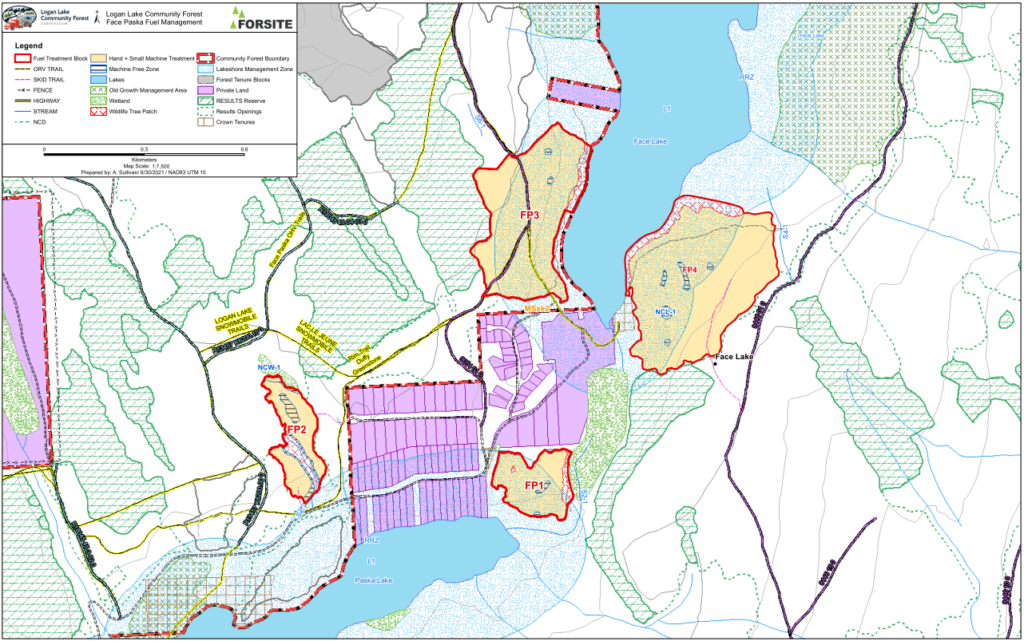Fuel Management in Face-Paska
April 12, 2023 Update
The pile burning planned for last fall was successfully carried out, and all work in the area is now complete.
August 17, 2022 Update
Between October 2021 and March 2022, the contract crews from Skeetchestn Natural Resource Corp. were able to finish the cutting and piling of all treatment areas identified in our plans. This phase of work was extremely difficult due to the heavy blowdown, but the crews were successful and did a fantastic job. We are incredibly thankful to the Skeetchestn crews and their supervisor Burke Nesjan for taking on this challenge.
The LLCF has been awarded the additional funding from the Forest Enhancement Society of BC (FESBC) required to finish the treatments. The funds invested by FESBC represent a significant step in reducing wildfire risk to the Face Paska community and the work would not be possible without their support. For anyone interested in learning more about FESBC, please visit their website https://www.fesbc.ca/.
The second phase of the project involves burning of debris piles, and will be initiated this September at the earliest (exact dates to be determined). There is a significant volume of material to burn on site, so this phase may take several months to complete. Our crews will be watching venting conditions and conducting burning in a manner to minimize smoke impacts to the community. A small excavator will be on site to support crews while burning and handle larger debris. Logs stacked for firewood will remain available for residents to collect. We ask residents to avoid entering treatment areas to collect firewood during active burning operations. We will update the community prior to burning commencing.
Thank you to all Face Paska residents for your patience and we look forward to completing the project! If you have any questions, please contact Adam Sullivan directly at asullivan@forsite.ca.
November 30, 2021 Update
Hello Face Paska Residents,
The treatments around the community have been progressing well and are about half way finished. The cutting and piling will be finished in treatment units FP1 and FP3 by the end of this week (December 3, 2021). From there, our contractor will be starting work in FP2 which we hope to have finished before the end of 2021. After the holidays, our crews will be returning to finish work in FP4, which will be complete by March 2022. Our crews may still need to do some work in these areas, so please do not enter if the work sites are active. Signage will be posted. Evenings and weekends remain the best times to collect firewood as our crews are not on site.
Logs suitable for firewood have been set aside in treated areas. Residents are encouraged to collect firewood in treated areas. Please focus on removing the logs that are decked (i.e. laid flat to the ground) and avoid the large pyramid shaped piles. Please ensure you have a valid firewood permit and are abiding by the permit requirements. Permits are available at the following link: https://www2.gov.bc.ca/assets/gov/farming-natural-resources-and-industry/natural-resource-use/firewood-permits/dtr_fup_firewood.pdf
Our goal is to have the cutting and piling complete in all four treatment units by March 2022, and return in fall/winter 2022 for a second phase of work to burn piles and bring the project to completion.
If you have any further questions, please contact Adam Sullivan, RPF at asullivan@forsite.ca.
July 2021 Update
Dear Face Paska Residents,
We hope everyone is staying safe during the intense fire season we are experiencing in BC this year, and we are truly sorry to hear about the evacuation of the community in response to the Durand Lake wildfire. Now more than ever, the LLCF is committed to the wildfire risk reduction work around Face Paska.
We would like to provide an update on our fuel management project as we have been in the process of finalizing plans since our virtual Open House in May. Note: this entire webpage has been updated to reflect changes to the project, including an updated prescription, maps, and key details below. We have some exciting updates on the treatments being implemented this fall:
- After some discussions in recent months, we have reached an agreement with Skeetchestn Natural Resource Corporation (SNRC) to take the lead role in implementation of the fuel treatments. Skeetchestn has access to the expertise, crews and equipment required to complete the work while meeting all the objectives of the fuel management prescription.
- We have removed the commercial harvesting component from the project altogether (i.e. no large-scale harvest equipment, no road building, no removal of timber, etc.). This decision was made after discussions with SNRC and agreeing the use of large-scale harvest equipment could result in more removal of live/healthy trees than we set in our draft plans. This would have adverse impacts on the watershed function, and go against commitments the LLCF made to the community to limit removal of live trees.
- All four treatment units (33 hectares) will be treated using hand crews and small equipment only. The dead material on site will be felled, bucked, and piled using small equipment (mini-excavator). The debris piles will be left on site for one year to dry out, and then burned in Fall 2022. This approach is generally more cost intensive, but after discussions with the funding program (Forest Enhancement Society of BC) about the constraints in this area, they agreed to the removal of the harvesting component.
- All material that is piled will be donated to the community as firewood where possible. Residents are responsible for obtaining a firewood permit and all costs and work required to access debris piles to collect firewood.
- The prescription, maps, and visual impact assessment on the LLCF website have been updated to reflect the new treatment approach (see below).
Thank you again for your patience as we continue to develop our plans. If you have any further questions, please contact Garnet Mierau, RPF at gmierau@forsite.ca or Adam Sullivan, RPF at asullivan@forsite.ca.
Background
The Face-Paska community is located northeast of Logan Lake, BC adjacent to Face and Paska Lakes. This residential and recreational area was identified as high risk from wildfire impacts and as a priority location for fuel management by the Logan Lake Wildfire Risk Management Plan (WRMP, 2018) and the BC Wildfire Service’s Provincial Strategic Threat Analysis (PSTA) dataset. This is due to excessive fuel loading of dead and downed trees, the proximity to the community itself (human life and safety), as well as other values in the area (e.g. critical infrastructure, evacuation routes, commercial interests & recreation trails).
Fire suppression activities over the past century along with extensive Mountain Pine Beetle related tree mortality have resulted in unnatural ecosystems that need to be treated in order to reduce the wildfire risk to the community. There is potential for catastrophic wildfires that could cause significant impact to a range of social, environmental and economic values.
Field reconnaissance identified the Fuel Treatment Units (FTUs) FP1, FP 2, FP 3 and FP4, based on fuels, topography, administrative boundaries, and the location of values at risk. All four units are located adjacent to private residences and a popular resort, and treatments are intended to increase public safety while providing for cultural, recreational, and ecological values in the area.
Fuel Treatment Approach
In order to mitigate this risk, the Logan Lake Community Forest Corporation (LLCFC) is planning a fuel treatment utilizing hand crews and small equipment including the following activities:
- Hand falling of standing dead trees or danger trees
- Hand spacing of understory stems (<12.5 cm DBH);
- Pruning of branches;
- Bucking and stacking of logs;
- Debris piling with small equipment; and
- Open burning.
The final result will be a forest that is safer for the community and fire suppression crews, reduced potential for future wildfires, and improved resilience of the forest ecosystems around Face-Paska.


Treatment Unit Summary
There are four treatment units:
- FP1 = 3.4 hectares
- FP2 = 3.2 hectares
- FP3 = 11.0 hectares
- FP4 = 15.4 hectares
- Total treatment area = 33.0 hectares

Key Facts
Area
Treatments cover approximately 33 hectares directly adjacent to the community.
Treatment Unit Location
Treatments are designed to address primary pathways of potential wildfire spread towards the community from the north (along the shores of Face Lake), east, and south. The treatments also reduce the likelihood that a human caused ignition from within the community will spread into the surrounding forests.
Timing of Operations
The majority of the hand and small machine work will take place over the fall/winter of 2021. During this time the hand falling, bucking, pruning, understory spacing, and piling work will occur. Debris piles will then be left out for one season to dry out, and burned in the fall of 2022.
Road Access
No new road construction is proposed. Hand crews and small equipment will access treatment units using new small equipment access trails, or existing roads and trails if they exist.
Watershed Function
The live and healthy trees within the proposed treatment units contribute to the hydrological function of watersheds around Face-Paska. Although some of these live trees must be removed for safety reasons or to make room for burn piles, this removal is expected to be around 5% of total live stems.
Riparian Features
All riparian features (i.e. lakes, streams, and wetlands) have been excluded from treatment areas or placed into internal reserves (e.g. Wildlife Tree Patches or Machine Free Zones).
Wildlife Habitat
The proposed winter timing window for operations will allow the majority of work to take place outside the active season (i.e. spring/summer) for key wildlife species (e.g. amphibians, migratory birds etc.). In addition, nesting trees/snags and the majority of live stems will be retained, and all riparian features have been excluded from the treatment area or placed into internal reserves.
Recreation Trails
The existing roads that will be utilized for treatment work are also designated as active Off Road Vehicle (ORV) and snowmobile trails. Recreation trails are not anticipated to be impacted in any significant way by hand/small machine treatments.
Firewood Donations
All material that is piled will be donated to the community as firewood where possible. Residents are responsible for obtaining a firewood permit and all costs and work required to access debris piles to collect firewood. Residents must obtain permission from the LLCF before collecting firewood, and only collect wood from piles designated for donations. Piles must be left in a state conducive to burning (i.e. not scattering of material/mess created). Residents assume all risk and responsibility for any injury or loss arising out of firewood collection, and the LLCF is in no way liable.
Visual Quality
The treatment units overlap legally designated Visual Quality Objectives (VQO). Visual quality will be maintained through the retention of live mature trees, and strategically placed reserves along the shoreline of Face Lake to provide visual screening. The LLCFC will complete a visual impact assessment as part of the prescription development process to ensure treatment plans will meet VQO (see assessment below).
Effectiveness Monitoring and Maintenance
An important component of LLCFC’s wildfire risk reduction program is long-term effectiveness monitoring and maintenance of treated areas. The proposed treatments in the Face-Paska area represent a ‘first pass’ and additional work in the future may be undertaken to address new hazards such as pests, windthrow, understory vegetation re-growth, or wildfire. Forests are dynamic ecosystems and long-term management activities may be required to maintain the forests around Face-Paska in a state that mitigates wildfire risk to the community. Future maintenance activities may include additional mechanical and/or hand treatments.
Calendar of Community Engagement
Feedback on the Face-Paska Fuel Management project is welcome at any time. The following key initiatives and events have been planned to enhance our community outreach and provide numerous opportunities for engagement.
| Timeline | Engagement Activity |
| March 2021 | Draft treatment plans and maps to be updated on the LLCF website |
| Ongoing | Treatment information provided on LLCF website, Facebook, and YouTube video. An online feedback form is available on our website for you to submit your comments, as well as contact information for our Forest Management Team to speak with us directly. |
| May 13, 2021 | Community webinar discussing wildfires, wildfire risk, and fuel treatments near the Face-Paska community. This event will be advertised on the LLCFC Facebook page and website, as well as through the community (Logan Lake, Face-Paska) directly. |
| Late Fall / Winter 2021 | Implement proposed treatments. |
Additional Information
The following video is a recording of the community webinar held on May 13, 2021 reviewing the fuel management treatments near the Face-Paska community. The second half of the webinar includes questions directly from the community.
